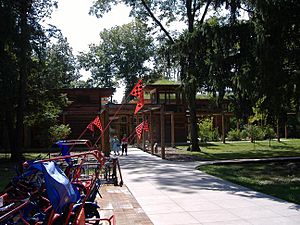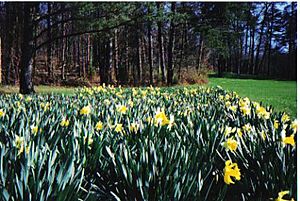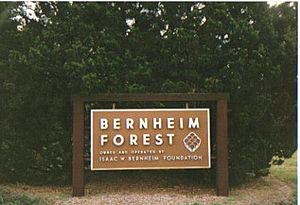Bernheim Arboretum and Research Forest facts for kids
Bernheim Arboretum and Research Forest is a giant forest and nature preserve in Clermont, Kentucky. It covers over 16,000 acres, which is like 25,000 football fields! It's a special place where you can explore nature, learn about plants, and enjoy the outdoors.
Bernheim was started in 1929 by Isaac Wolfe Bernheim. He was an immigrant from Germany who became a successful businessman. He bought the land in 1928 for a very low price because it had been damaged by mining. A famous design company, Frederick Law Olmsted, helped plan the park. It officially opened in 1950. Mr. Bernheim gave this huge forest to the people of Kentucky. It is the biggest privately owned natural area in the state. Isaac Bernheim and his family are buried here.
In 1988, the forest decided to focus more on its plant collections and research. So, its name changed to Bernheim Arboretum and Research Forest. An "arboretum" is like a living museum for trees. Even with the new name, many local visitors still call it "Bernheim Forest." In recent years, Bernheim has grown a lot. It now has many volunteers and offers fun workshops and classes. It also hosts big events every year. These include ColorFest in October and Bloomfest in May. There's also CONNECT in August, which mixes art, science, and nature.
Contents
Exploring Bernheim: What to See and Do
Bernheim is split into two main parts: the arboretum and the natural forest. The arboretum is where you'll find many different kinds of plants. It also has modern buildings and easy-to-use paths.
Arboretum Highlights
The arboretum has lots of walking paths. You can visit the main visitor's center, a cafe, and a gift shop. There's also an education center for learning. Kids will love the newly updated play area. There are also four beautiful lakes to enjoy.
Natural Forest Adventures
The natural forest area has most of Bernheim's hiking trails. It's mainly a forest with beech and maple trees. You can get to these trails by paved roads. There are over 35 miles of hiking trails and scenic roads. The Millennium Trail is the longest at 13.3 miles. It's a challenging hike, so Bernheim asks hikers to start early. There's also a paved Hike-Bike Pike for walking and biking.
You can climb a metal observation tower called the Fire Tower Loop. It gives you amazing views! There's also a canopy walk that lets you look out over the treetops. Trails range from easy walks to tough hikes for experienced adventurers.
Visiting Hours and Activities
Bernheim is open every day from 7 a.m. until sunset. It's closed only on Christmas Day and New Year's Day. The visitor's center, gift shop, and art gallery are open from 9 a.m. to 5 p.m. daily.
You can do many things at Bernheim, like:
- Walking, running, and hiking
- Having picnics
- Watching birds
- Bicycling
- Identifying plants
- Taking photos
- Fishing
- Attending special events
Dogs are welcome at Bernheim, but they must always be on a leash. They are not allowed in some areas.
Eco-Friendly Visitor Center
In 2005, a new visitor's center opened. It's a very special building because it's super eco-friendly. It was designed by William McDonough + Partners. The center is made from recycled materials. It even has live plants growing on its roof! The parking lot was placed so that mushrooms could help clean up car pollution. This keeps nearby water clean. The building won a top award for its green design.
Memberships and Fees
You can become a Bernheim member for free year-round entry. Members also get discounts on programs and in the shop. For non-members, weekdays are free. On weekends and holidays, there is a small fee. It's $5 for cars and motorcycles. Larger vehicles like vans and RVs cost $10, and buses are $20.
Isaac W. Bernheim's Special Vision
Before he passed away, Isaac Bernheim wrote a letter in 1939. In it, he shared his dreams for the forest. He wanted it to be a place for everyone.
Here are some of his main goals:
- No talks about religion or politics, and no buying or selling things.
- Everyone should be treated equally, no matter if they are rich or poor.
- He dreamed of a beautiful building with an art gallery. It would have statues of famous Kentuckians. This would inspire young people.
- He wanted a museum of natural history with animals from this part of the world.
- A tall flagpole would fly the American Flag. It would be a place for patriotic gatherings, especially for children. They would learn about freedom.
- He invited everyone to come and enjoy nature. He hoped the park would always be free for people to use.
Mr. Bernheim was a true visionary. He knew the world would change. He believed that "nothing is static in this world." He wanted his wishes to be respected as much as possible.
Bernheim also believed that art helps us connect with nature. Today, there are many sculptures in the arboretum. There's also an Artist in Residence Program. This program invites artists to live and work at Bernheim. They create art that helps people connect with nature. Artists share their work through workshops and displays.
The Arboretum: A Living Plant Museum
The arboretum covers 240 acres. It has over 1,900 different kinds of trees, shrubs, and plants. Each one is carefully labeled. It has a huge collection of American holly plants. Other big collections include maples, crab apples, conifers (like pine trees), oaks, and dogwoods.
Special spots in the arboretum include the sun and shade trail and the quiet garden. The arboretum's design started in 1935 and has improved over the years. In 1994, Kentucky officially named Bernheim its state arboretum. Remember, you are not allowed to pick leaves or clippings from the plants.
Famous Holly Collection
The arboretum's holly collection is one of the best in North America. It's named the Buddy Hubbuch Holly Collection. Buddy Hubbuch was Bernheim's first horticulture director. He oversaw the planting of this collection for 33 years. It has over 700 holly plants. These include many types of American Holly and Japanese Holly.
Art and Buildings in Nature
The buildings and art at Bernheim help us feel more connected to nature. They inspire us to explore our deep bond with the natural world.
Landscape Design
The famous Fredrick Law Olmstead firm designed the arboretum in 1931. They created roads, paths, and natural areas. They planted trees and turned old farmland into meadows and forests. Lakes and ponds were added to make the area more lively. Bernheim Forest opened to the public in 1950. Experts at Bernheim continue to improve the gardens and natural areas.
Main Buildings at Bernheim
Education Center
This building was first called the Nature Center and finished in 1962. It's used for many things today. It has offices and is a popular spot for educational events. It also has a room where you can watch wildlife. It's open all year.
Garden Pavilion
The Garden Pavilion was designed in 1961. It's a six-sided building by Lake Nevin. Vines cover a walkway around it, which keeps the building cool in summer. You can rent the Garden Pavilion for weddings or meetings.
Research Building
The Research Center opened in 2004. It has offices and labs for studying plants and forest management. Scientists here study things like climate change, bird migration, and insects. They also grow special plants in greenhouses.
Visitors Center
The new Visitor Center opened in 2005. It's known for being very eco-friendly and won many awards. It was designed to look like a tree, with living roofs and other features. These designs help it fit in with Kentucky's natural environment.
The Intergenerational Grisby Shelter
This shelter is in the Children's Play Garden. It has five structures with living green roofs. They offer seating, shelter, and shade. The columns are made from recycled trees found in the forest.
Bernheim Lookout
The Bernheim Fire Lookout was built in 1929. It's a 48-foot tall tower with a small metal room at the top. It was used to watch for fires until 1980. It's now a historical landmark. The Bernheim Foundation helps take care of it.
Art in Nature Program
The Art in Nature program helps visitors discover art hidden in the forest. It inspires a deeper connection with nature. This program includes the Artist in Residence Program. It also features "Sited @ Bernheim," which brings new art installations.
Here are some of the sculptures you can find at Bernheim:
- Snake Hollow by Patrick Dougherty (2012): This sculpture looks like a giant snake or maze. It's made from willow branches woven together. It was built by the artist and over 50 volunteers. It's environmentally friendly and will naturally return to the earth after about two years.
- Earth Measure by Matt Weir (2013): This sculpture honors Barry Bingham Jr., who loved nature and Bernheim. It's made from over a ton of stacked limestone blocks. It invites you to explore science, shapes, and sounds in nature. You can listen to the sounds of wildlife through its special design.
- Hello by Russell Vogt (2009): This colorful ceramic sculpture is made of mosaic tiles. It's a fun and whimsical piece.
- Untitled by Jerry Bleem (2002): This unique bronze sculpture was created using thousands of staples.
- Untitled by Heike Endemann (2011): Heike Endemann created three abstract sculptures from fallen logs using a chainsaw. You can find them in different spots around Bernheim.
- Cluster III by Ernest Shaw (1976): This large, abstract sculpture is made of steel. It forms three points of a triangle within the Holly Collection.
- Let There be Light by George Grey Barnard: This beautiful bronze statue is at Isaac Bernheim's grave. It shows a woman with her arms raised. A plaque at its base reads: "May light, the symbol of life and truth, illumine the paths of good citizenship and reason, and tolerance and fairness guide our relationship with our fellow men."
- Lincoln Statue by George Grey Barnard (1922): A copy of a famous Lincoln statue stands in Louisville. It was paid for by Mr. and Mrs. Isaac Bernheim.
- Untitled by Paul Fields: This limestone sculpture was started by Bernheim's first Artist in Residence in 1980. It's an abstract, organic shape.
- Untitled by Paul Fields (2003): This "blossom" shaped sculpture is also by Paul Fields. It's located on the Lake Nevin Loop Trail.
- Emerging by Meg White (1988): This bronze sculpture was donated in memory of a former Bernheim board member. The artist is self-taught and creates wildlife and human figures.
- Hymn to Justice by William Pierson Merrill: This is a stanza from a song about justice and equality. It's located on Tablet Hill near the main entrance. It reflects Mr. Bernheim's belief in treating all people with respect.
- Untitled by Tom Butch (1988): This abstract red steel sculpture is by Lake Nevin. Its design allows you to see different shapes as you walk around it.
- Our Precious Forest, Stricken, and Ying Yang by Karl Ciesluk (1998): Karl Ciesluk created many artworks throughout Bernheim. These pieces are made of tiny mirrored squares. They glitter and reflect the surrounding nature.
Protecting Nature: Conservation at Bernheim
Bernheim is also focused on protecting its natural environment. For example, a project helped restore Wilson Creek. This creek had been straightened for farming in the past. Now, it flows naturally again. Native trees and wildflowers were planted. This helped fish populations grow. Beavers have even returned to the creek. Their dams have made the water clearer and attracted many animals. These include birds, amphibians, reptiles, raccoons, and river otters.
See also
 In Spanish: Bernheim Arboretum and Research Forest para niños
In Spanish: Bernheim Arboretum and Research Forest para niños





